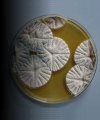Black Toxic Mold
"Black toxic mold" and "black mold" are common names for the Stachybotrys chartarum species of mold. Stachybotrys chartarum is classed as a toxic mold because it produces extremely toxic mycotoxins.Out of all the toxic molds, black toxic mold is the most well known because there have been so many cases of black toxic mold problems in houses devastating the residents' health.
Identifying Black Toxic Mold
Black toxic mold looks black or dark green. When black toxic mold is growing it has a distinctive shiny, slimy looking surface. However if black toxic mold dries out it can turn gray and powdery looking.There are other molds which look similar to black toxic mold and so the only way to confirm whether a mold colony is definitely black toxic mold is to have an expert check it under a microscope.
If you want to test mold growth which you think could be black toxic mold you should talk to a professional mold specialist. (Black Mold Testing)
Conditions, Causes and Where Black Toxic Mold Grows
Black toxic mold needs a lot of moisture before it can begin to grow. For black toxic mold to grow on an area the material has to be very wet for at least a week. Because of this, black toxic mold is usually only found in houses with significant water damage, usually caused by flooding or leaks which weren't repaired for a long time. Once black toxic mold has started to grow it still needs constant moisture to keep on growing.As for a food source, black toxic mold needs substances high in cellulose and low in nitrogen to grown on. This means black toxic mold is able to grow on most indoor building materials. Black toxic mold is most commonly found on:
- Drywall aka sheetrock
- Paper products
- Insulation
- Wallpaper
- Carpet
- Wood
- Ceiling tiles
Most black toxic mold problems in houses occur with the black toxic mold colony growing hidden from sight. Black toxic mold can thrive behind wall panels, in ceilings or in floors without showing any visible signs inside the room itself. Hidden black toxic mold growth is usually caused by hidden leaks in the wall, roof or floor.
Black Toxic Mold Spores
Black toxic mold spores are allergenic just like the spores from other mold species. However black toxic mold spores are also toxic because they carry mycotoxins on them.Black toxic mold spores are much heavier than most other mold spores though and so they don't stay airborne for long. Even in houses with black toxic mold problems you won't often find black toxic mold spores in the air.
The spores of black toxic mold do not usually spread into houses through the air. They are often carried inside instead, especially through flooding or on building materials during construction.
When Black Toxic Mold Releases Spores
When black toxic mold spores are still inside the mold colony they are held inside a gelatinous mass which prevents them from escaping into the air. These spores can be released though if the black toxic mold is disturbed or if it dries out.When black toxic mold is sporulating the slimy gelatinous layer becomes dry and powdery allowing the spores to float free. Changes in environmental conditions can also trigger black toxic mold to sporulate.
Black Toxic Mold Mycotoxins
Black toxic mold produces trichothecene mycotoxins which are one of the most toxic and resilient types of mycotoxins. These mycotoxins can be found throughout all parts of a black toxic mold colony as well as on the airborne spores of black toxic mold.Black toxic mold colonies do not constantly produce and release mycotoxins though. Whether black toxic mold produces mycotoxins depends on what substance the mold is growing on and on other environmental factors like temperature and humidity. If black toxic mold is stressed or disturbed it might also begin to produce mycotoxins. There are probably also other unknown factors too.
How Black Toxic Mold Mycotoxins Affect Humans
Humans are exposed to black toxic mold mycotoxins by ingestion, by the mycotoxins entering the body through the skin or through inhaling the mycotoxins. Inhaled mycotoxins are the most dangerous to humans and the most common exposure route for people living with black toxic mold in their home.The mycotoxins of black toxic mold are immunosuppressive and cause a range of symptoms including mental impairment, respiratory problems and organ damage.
About Us
Related Articles
Black Mold SymptomsBlack Mold Testing and Inspection
Black Mold Removal
Mycotoxins



